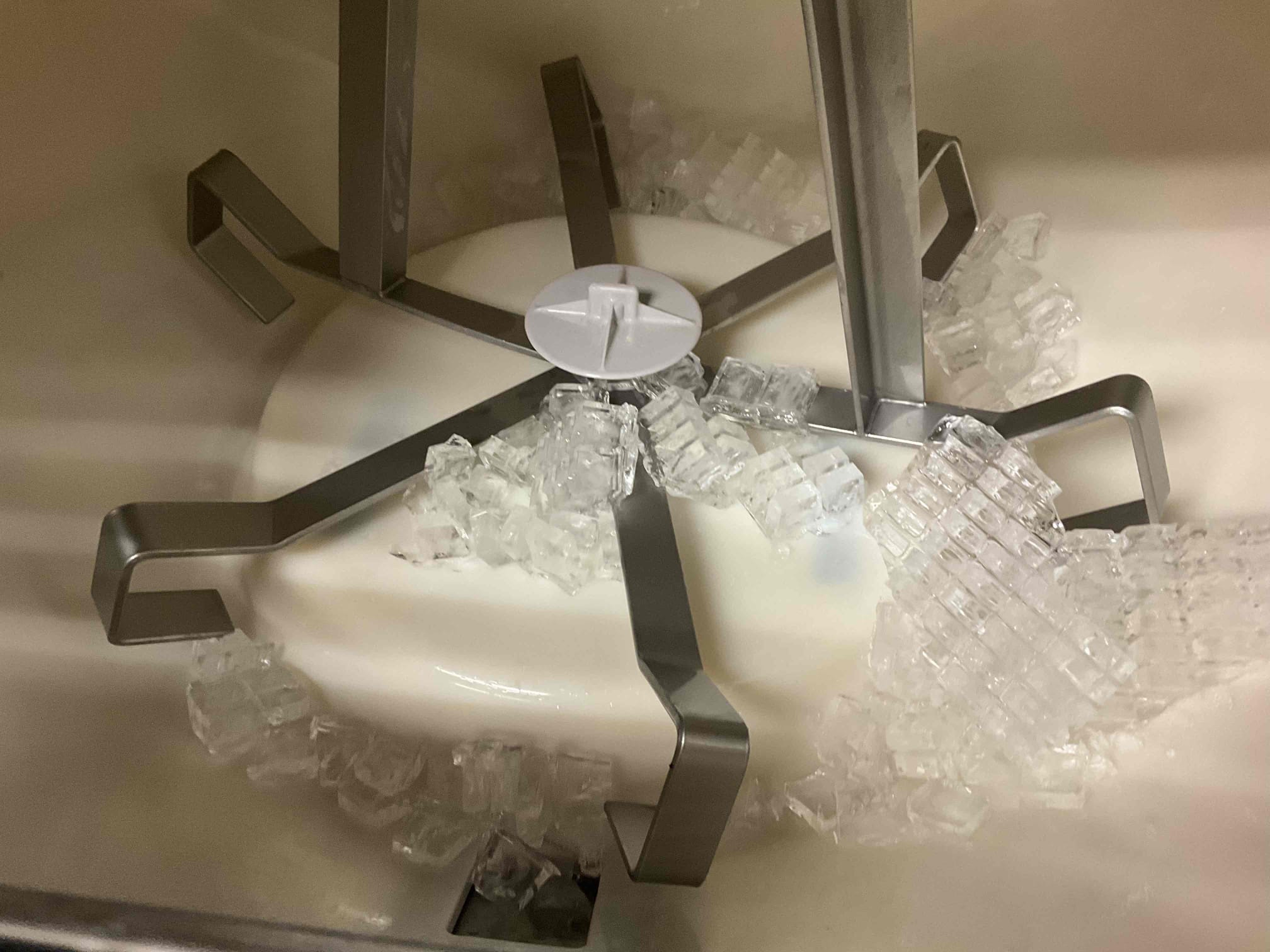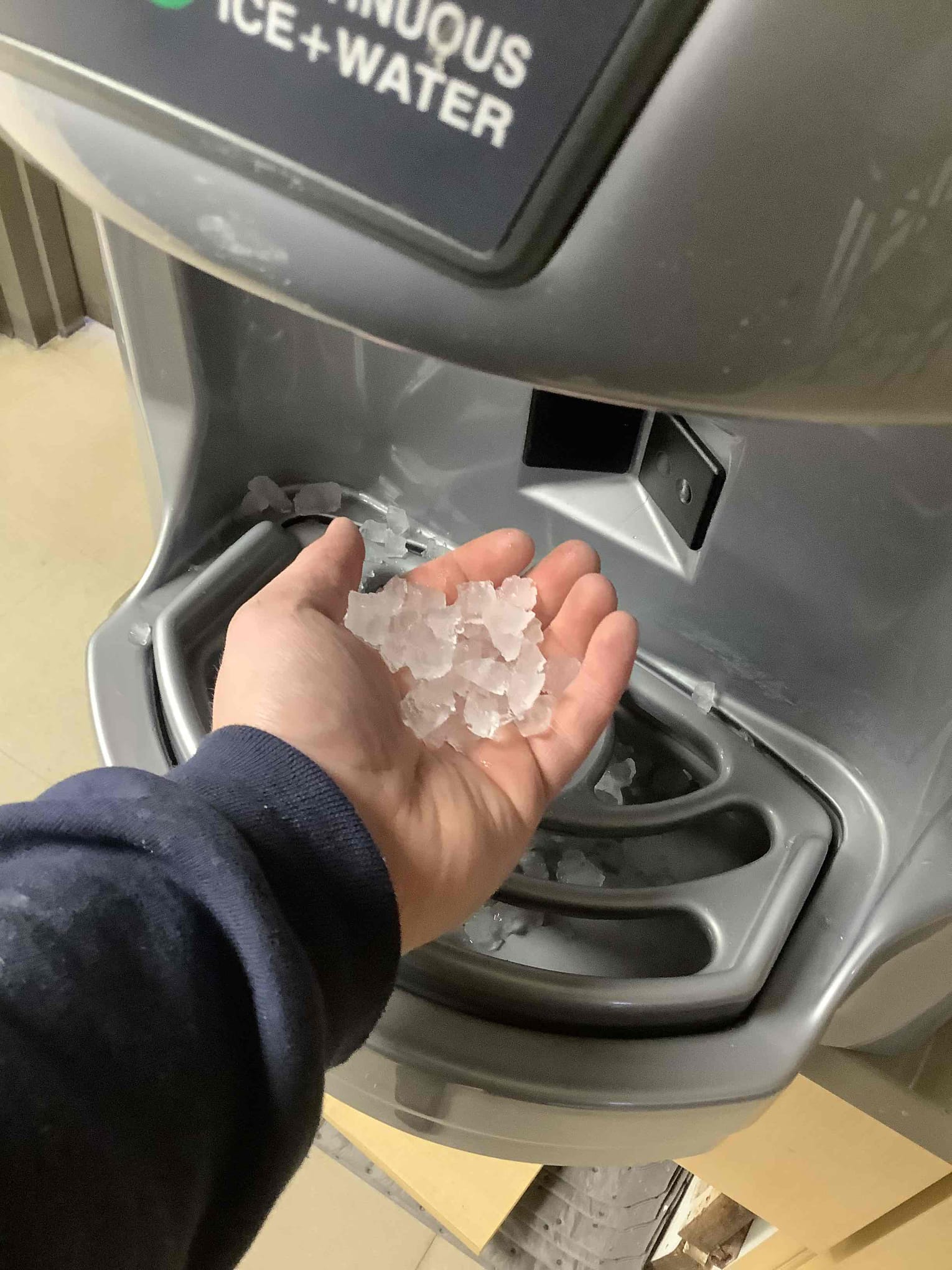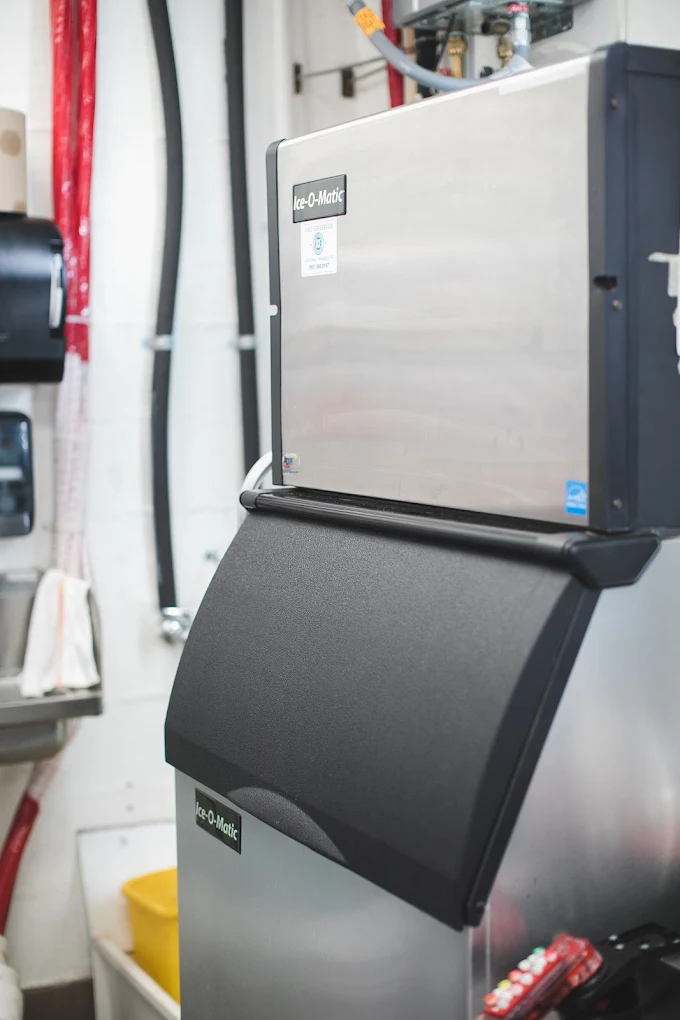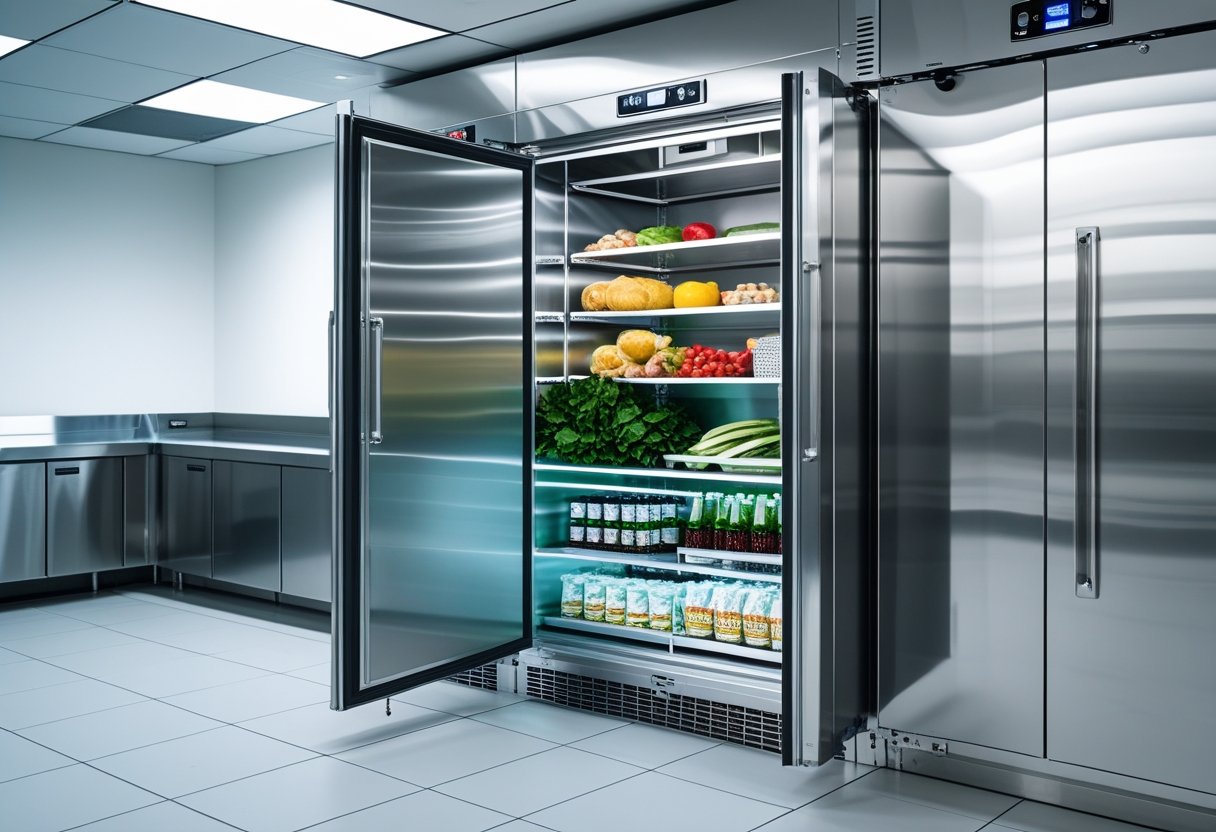proudly serving
the mid-south

Best Practices for Storing Ice to Keep It Fresh and Clean
Storing ice the right way keeps it clean, fresh, and safe for everyone. The best way? Use a clean, well-maintained ice bin that keeps out germs and controls temperature. It sounds simple, but it really does prevent slime, mold, and all those gross issues that pop up when you ignore your ice storage.
Regular cleaning and a little maintenance go a long way. At Memphis Ice, we’ve been helping Mid-South businesses stay cool and headache-free since 1977, so trust us—good ice storage keeps your kitchen, bar, or hospital running smoother.
If you store ice correctly, you don’t just keep things hygienic—you help your ice machine last longer and make service calls less of a hassle. Honestly, these best practices are easier than you might think, and they’re worth it for the quality your customers get.
Choosing the Right Ice Storage Containers
Picking a good container for your ice matters more than you’d expect. The right material, proper size, and food-safe design all add up to cleaner, fresher ice and less stress during a rush.
Materials and Insulation
What your ice storage bin is made of affects how long it lasts and how cold it keeps your ice. Stainless steel bins are popular—they’re tough and don’t rust. Thick plastic bins with solid insulation work if you’re short on space.
Insulation’s a big deal. Industrial-grade insulation slows melting, so you lose less ice and save on energy. Lids or doors that seal tight keep warm air out when you’re grabbing ice. If you can, look for that extra insulation—it’s worth it.
Container Size Considerations
Size definitely matters. Figure out how much ice you use and where your bin will go. Measure your space so you don’t end up with a bin that won’t fit. If you need to store a lot, go for a bigger, deeper bin.
Think about how ice moves through the bin. Some bins use a “first-in, first-out” system, so you’re always using the oldest ice first. Fresher ice, less waste. If you’re squeezed for space, compact bins around 31 inches deep can fit in tighter spots.
BPA-Free and Food-Safe Options
Always pick BPA-free, food-safe containers. BPA can leach into ice, and nobody wants that. Look for “food-safe” labels for peace of mind.
Smooth, non-porous surfaces make cleaning easier. Avoid bins with cracks or rough patches where germs hide. A good container keeps your customers safe and your business on the right side of the rules. Memphis Ice stocks bins that check all these boxes.
Optimal Temperature and Storage Locations
Temperature and location are huge for ice quality. You want to stop melting, block contamination, and keep your ice clear. That means dialing in your freezer settings, picking the right freezer spot, and avoiding temperature swings.
Freezer Settings for Ice
Set your freezer at 0°F (-18°C) or colder. That keeps ice from melting or sticking together. If it’s warmer, you’ll end up with mushy, clumped ice—no thanks.
Don’t go too cold, though. Below -10°F (-23°C), ice can get brittle and chip. Keep a thermometer in the freezer and check it every day.
Check your freezer’s thermostat from time to time, and schedule maintenance so everything runs right. Good temperature control saves money and keeps your ice just right.
Best Placement Within the Freezer
Put ice in the coldest part of the freezer—usually the back or bottom, away from the door. Don’t store it near vents where warm air sneaks in.
Always use sealed containers to keep ice clean. Open bins or bags let in smells and germs. Label your bins so nobody mixes things up.
Keep ice machines and bins away from ovens or other heat sources. Less heat means fewer temperature swings and fewer headaches.
Avoiding Temperature Fluctuations
Temperature swings melt ice a little, then it refreezes and gets cloudy or breaks apart. Don’t open the freezer door more than you have to, and don’t leave it open.
Check seals and gaskets now and then. If they’re worn out, warm air gets in and messes with your ice. Fix any issues fast.
Try not to store ice in freezers packed with hot food. If you can, use a dedicated ice freezer for the steadiest temps.
Preventing Ice Contamination
Clean ice comes down to how you handle it, where you store it, and how you keep out odors and germs. Here’s what actually works to keep every cube safe and fresh.
Hygienic Handling Practices
Use clean scoops or tongs every time—never your hands. Wash and sanitize these tools often, and keep them in a clean holder near the bin.
Don’t put ice bins near trash, chemicals, or messy prep areas. If you run a business, make hand washing a must before anyone touches ice equipment.
Clean your ice machine and bin regularly. Dirt, mold, and slime sneak in fast if you skip this, and they’ll ruin your ice’s taste. For busy places, Memphis Ice recommends cleaning every 1-3 months.
Minimizing Exposure to Odors
Ice picks up smells like a sponge. Keep bins in cool, ventilated spots, far from strong odors, cleaning products, or trash.
If you use a walk-in cooler, seal off the ice bin from anything smelly—onions, fish, chemicals, whatever. Don’t let ice sit next to stuff that stinks.
Keep your machine’s water supply clean and free of weird tastes. Change filters and check water lines so your ice stays neutral.
Sealing and Covering Ice Properly
Always cover your ice bins with tight lids. This keeps out dust, bugs, and floating germs. Open-air bins are just asking for trouble.
If your bin doesn’t have a lid, get a cover or switch to a bin with one built in. Keep it closed when you’re not scooping ice.
A good seal also protects ice from melting or refreezing, which messes with the quality. Memphis Ice can help you find the right storage solution for your setup.
Maintaining Ice Quality and Freshness
Fresh ice depends on how you store and handle it day-to-day. If you ignore it, you’ll get stale flavors, clumps, and freezer-burned cubes. Stay on top of rotation, prevent clumping, and watch for freezer burn.
Regularly Rotating Stored Ice
The longer ice sits, the more it soaks up nearby smells and flavors. Rotate your supply—use old ice first, refill with fresh cubes.
Check your ice every day. Toss anything cloudy or with a weird smell. It’s a quick step, but it keeps your ice tasting clean. Memphis Ice suggests making this a daily habit.
Avoiding Ice Clumping
Clumping happens when moisture makes the cubes freeze together. Usually, it’s from opening the bin too much or exposing ice to warm air. Clumps slow you down and waste ice.
Keep your bin tightly covered and only open it when you need to. Use clean scoops, not hands, to cut down on moisture. Storing ice in smaller batches or using bins that fight condensation helps, too.
Monitoring for Freezer Burn
Freezer burn dries out ice and leaves it with a frosty, bitter taste. You’ll spot it as white, rough patches. Nobody wants that in their drink.
Check your ice for these signs and toss any cubes that look or taste off. Keep bins sealed and dry air out. If your freezer isn’t holding temp, call for a service check. Memphis Ice can help keep your gear running right.
Cleaning and Sanitation Best Practices
A clean bin is non-negotiable for safe, tasty ice. Regular cleaning and sanitizing stop mold, slime, and bacteria from taking over.
Routine Cleaning Schedule
Stick to a cleaning routine. Clean your ice bin or machine weekly, or more if you notice buildup or strange smells. Always drain the ice and water first.
Scrub every surface with mild detergent and warm water, getting into corners where gunk hides. Rinse well, then sanitize with something food-safe—bleach solution or a commercial sanitizer works.
Let the bin air dry with the lid open. Keeping up with this stops mold, slime, and mineral gunk from ruining your ice.
Disinfecting Containers and Scoops
Clean and sanitize containers and scoops every day. They touch the ice directly, so they’re hotspots for germs.
After each use, wash scoops and bins with hot, soapy water. Rinse, soak in sanitizer for a minute, then air dry. Damp tools just grow more bacteria.
Store scoops outside the bin in a covered holder. It keeps them clean until you need them again.
Follow these cleaning steps and your ice will stay safer. Memphis Ice can set you up with a maintenance plan if you want one less thing to worry about.
Long-Term vs. Short-Term Ice Storage
How you store ice depends on how long you need it. Short-term storage keeps ice ready for right now. Long-term means holding big batches without losing quality.
Strategies for Parties and Events
For parties, stash ice in airtight coolers to keep it clean and slow melting. Don’t open the cooler more than you have to. Put it in a shady, cool place to delay melting.
Store ice in clear bags or containers in small amounts. That way, you only expose what you need. Need ice fast? Fill trays a few hours ahead—most freeze in about four hours.
Keep ice away from anything that smells strong. It’ll pick up flavors in no time. Always use a scoop, not your hands.
Bulk Ice Storage Tips
For lots of ice, use a walk-in freezer or a commercial ice machine bin. Clean the bin regularly—dirty bins make ice melt faster and taste funky.
Keep the bin’s temperature below 32°F so cubes stay solid. Don’t overfill; air needs to circulate.
Label and rotate your stock so the oldest ice gets used first. That way, you avoid cloudy, stale cubes.
At Memphis Ice, we’ve seen how good bulk storage keeps businesses ready for the rush. Regular maintenance on your machine or freezer keeps the ice coming and the quality high.
Eco-Friendly Ice Storage Solutions
Storing ice properly lets you save energy and cut down on waste. Insulated ice bins made with tough, industrial-grade materials keep ice colder for longer, so your machine doesn’t have to kick on as often. That means less electricity used—always a win.
Big doors on bins? They’re handy, but every time you open one, warm air sneaks in and melts the ice faster. Try to keep doors closed as much as you can. It’s a simple thing, but it really helps keep things cold.
Cleaning matters more than folks think. When bacteria or gunk build up, your machine has to work overtime—or it might even break down. If you clean your ice bin often, you help the machine last longer and dodge expensive repairs. Not exactly glamorous work, but worth it.
Don’t forget about water management. Good drainage stops puddles from forming around your ice maker, which can waste energy and mess with your equipment. It makes things run smoother and helps you avoid headaches later.
Here’s a quick checklist for greener ice storage:
- Stick with insulated, well-sealed bins
- Keep those doors closed
- Clean bins regularly
- Make sure drainage is working
- Stay on top of maintenance
These steps aren’t just about the environment—they’re good for your bottom line, too. If you’re not sure where to start, maybe chat with a Memphis Ice expert and see what fits your setup.
Troubleshooting Common Ice Storage Problems
If your ice tastes weird or looks cloudy, first thing—check if your bin’s clean. A dirty bin can make ice taste off and look cloudy. Regular cleaning keeps ice clear and safe for drinks.
If you notice ice melting fast or sticking together, your storage might be too warm. Double-check the temperature and keep it cold enough to stop the melt, but not so cold everything fuses into a block.
Ice machines love to beep or flash lights when something’s up. Usually, it’s a clogged filter, low water, or maybe an electrical glitch. Don’t just ignore those alerts—they’re trying to help you catch small problems before they get big.
Here’s a quick checklist to troubleshoot:
| Problem | Possible Cause | Suggested Fix |
| Cloudy or bad-tasting ice | Dirty bin or water quality | Clean bin; check water filter |
| Ice melting too fast | Warm storage temperature | Adjust temperature settings |
| Machine beeping | Filter clog or water issue | Inspect filters; check water line |
| Ice cubes sticking | Excess moisture | Empty bin often; improve airflow |
Honestly, we’ve seen just about every ice storage issue at Memphis Ice. Keeping your bin clean and cold can save you a lot of trouble. Not sure what to do? Reach out to someone who knows the ropes—don’t wait until it turns into a bigger mess.
Frequently Asked Questions
The basics? Keep your ice cold, use clean storage, and pick the right containers. Watch out for odors, handle ice the right way, and clean things up regularly to keep taste and quality on point.
What’s the ideal temperature for storing ice to ensure it lasts longer?
Aim for 0°F (-18°C) or colder. That’s cold enough to stop melting and refreezing, which keeps ice from turning into a big clump.
How can I prevent my ice from absorbing odors while in the freezer?
Go with airtight containers or sealed bags. And keep your freezer clean—nobody wants onion-flavored ice.
Could you suggest the best type of containers for ice storage?
Plastic containers with tight lids or heavy-duty resealable bags work best. They keep out moisture and weird smells better than open bins.
Is it better to store ice in small batches or one large block?
Small batches are easier to grab and use, but big blocks melt slower. Pick what works for how you use your ice—there’s no perfect answer.
What are some hygienic handling tips when accessing stored ice?
Use clean scoops or tongs, not your hands. Try to keep scoops dry and stash them outside the ice so you don’t accidentally contaminate the whole batch.
How often should I clean my ice storage area to maintain quality?
Try to clean your storage area about once a week. That routine goes a long way in stopping bacteria from building up and helps your ice stay fresh.
At Memphis Ice, we suggest staying on top of ice machine and storage area maintenance. It’s one of those little things that keeps your business running smoothly year-round.
Recent News

Best Practices for Storing Ice to Keep It Fresh and Clean

Best Temperature Settings for Different Refrigeration Systems Explained Simply

The Secret Ingredient for a Stress-Free Thanksgiving: Ice

Benefits of Full-Service Ice Machine Rental for Stress-Free Event Planning

Bar Ice Machine Maintenance Service Tips for a Smooth-Running Bar

Why You Should Inspect Door Seals on Walk-In Coolers Regularly to Save Energy and Prevent Spoilage



